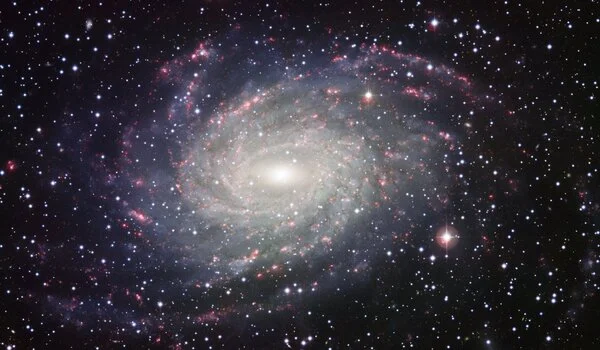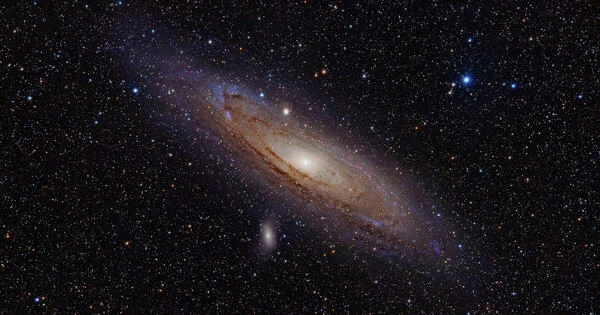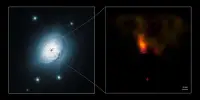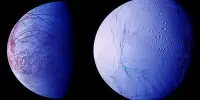The sharp eyes of an amateur astronomer examining archival data processed by NSF’s NOIRLab’s Community Science and Data Center led to the discovery of an unusual ultra-faint dwarf galaxy on the outer fringes of the Andromeda Galaxy. Professional astronomers using the International Gemini Observatory, a program of the National Science Foundation’s NOIRLab, discovered that the dwarf galaxy — Pegasus V — contains very few heavier elements and is most likely a fossil of the first galaxies.
Using several facilities from the National Science Foundation’s NOIRLab, researchers discovered an unusual ultra-faint dwarf galaxy on the outskirts of the Andromeda Galaxy. The galaxy, known as Pegasus V, was discovered as part of a systematic search for Andromeda dwarfs led by David Martinez-Delgado of the Instituto de Astrofsica de Andaluca in Spain, when amateur astronomer Giuseppe Donatiello discovered an intriguing’smudge’ in data in a DESI Legacy Imaging Surveys image. The photograph was taken with the Dark Energy Camera, which was built by the US Department of Energy, on the Victor M. Blanco 4-meter Telescope at Cerro Tololo Inter-American Observatory (CTIO). The data were processed using the NOIRLab’s Community Science and Data Center’s Community Pipeline (CSDC).
Deeper observations with the larger, 8.1-meter Gemini North telescope equipped with the GMOS instrument revealed faint stars in Pegasus V, confirming that it is an ultra-faint dwarf galaxy on the outskirts of the Andromeda Galaxy. In Hawai’i, Gemini North is one half of the International Gemini Observatory.
The Gemini North public-access telescope offers a wide range of capabilities for community astronomers. In this case, Gemini assisted this international team in confirming the dwarf galaxy’s presence, physically connecting it to the Andromeda Galaxy, and determining the metal-deficient nature of its evolved stellar population.
Martin Still
The Gemini observations revealed that the galaxy appears to be extremely deficient in heavier elements when compared to similar dwarf galaxies, implying that it is very old and may be a fossil of the Universe’s first galaxies.
“We have found an extremely faint galaxy whose stars formed very early in the history of the Universe,”commented Michelle Collins, an astronomer at the University of Surrey, UK and lead author of the paper announcing this discovery. “This discovery marks the first time a galaxy this faint has been found around the Andromeda Galaxy using an astronomical survey that wasn’t specifically designed for the task.”
The faintest galaxies are thought to be the remains of the very first galaxies to form, and these galactic relics contain information about the formation of the first stars. While astronomers anticipate that the Universe is teeming with faint galaxies like Pegasus V, they have yet to discover nearly as many as their theories predict. If there are truly fewer faint galaxies than predicted this would imply a serious problem with astronomers’ understanding of cosmology and dark matter.
Finding examples of these faint galaxies is thus an important, but difficult, endeavor. Part of the difficulty is that these faint galaxies are extremely difficult to detect, appearing as a few sparse stars hidden in large images of the sky.

“The trouble with these extremely faint galaxies is that they have very few of the bright stars which we typically use to identify them and measure their distances,” explained Emily Charles, a PhD student at the University of Surrey who was also involved in the study. “Gemini’s 8.1-meter mirror allowed us to find faint, old stars which enabled us both to measure the distance to Pegasus V and to determine that its stellar population is extremely old.”
The high concentration of old stars discovered in Pegasus V suggests that the object is a remnant of the first galaxies. When compared to the other faint galaxies around Andromeda, Pegasus V appears to be unusually old and metal-poor, indicating that star formation stopped very early.
“We hope that further investigation of Pegasus V’s chemical properties will provide clues into the Universe’s earliest periods of star formation,” Collins concluded. “This early Universe fossil galaxy may help us understand how galaxies form and whether our understanding of dark matter is correct.”
“The Gemini North public-access telescope offers a wide range of capabilities for community astronomers,” said Martin Still, Gemini Program Officer at the National Science Foundation. “In this case, Gemini assisted this international team in confirming the dwarf galaxy’s presence, physically connecting it to the Andromeda Galaxy, and determining the metal-deficient nature of its evolved stellar population.”
Future astronomical facilities are expected to shed more light on distant galaxies. Pegasus V witnessed a period in the history of the Universe known as reionization, and other objects from this period will be observed soon with NASA’s James Webb Space Telescope. Astronomers hope to discover more faint galaxies in the future using the Vera C. Rubin Observatory, a program of the National Science Foundation’s NOIRLab. The Rubin Observatory will conduct the Legacy Survey of Space and Time, an unprecedented decade-long survey of the optical sky (LSST).
















